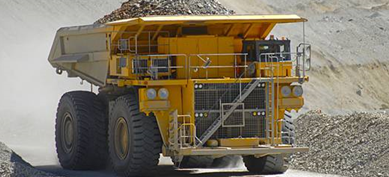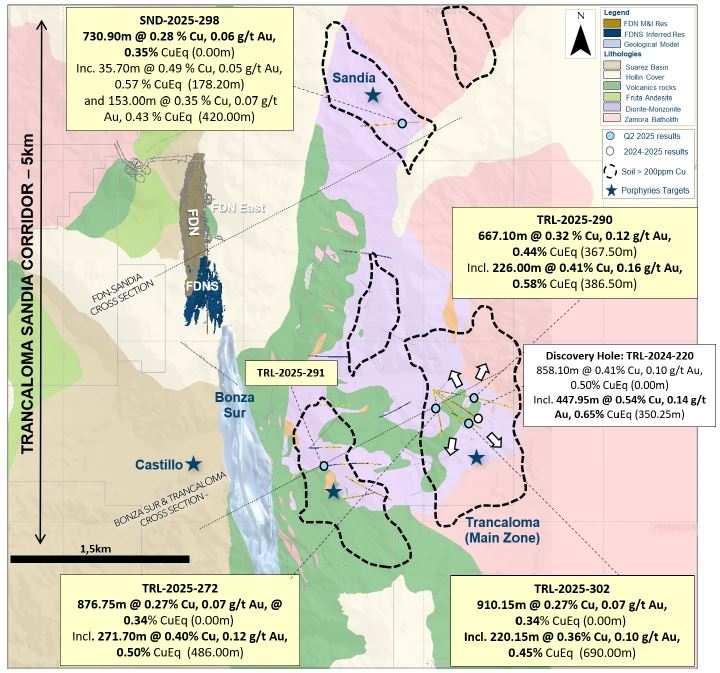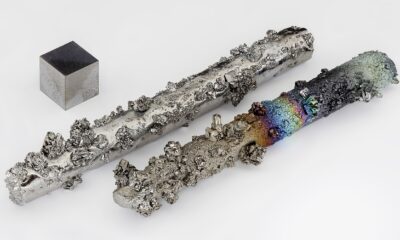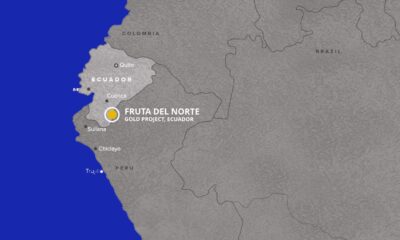Nyheter
David Hargreaves on Bulk Minerals, week 43 2013

 Sweden makes a move. The north European country, long famous for iron and steel, is making a comeback in that sector. The government has committed the equivalent of $200 million in upgrading the road from Kaunisavaara to the reloading terminal in Pitkajarv plus a similar amount to accommodate the expected increased capacity in iron ore shipments from minors such as Northland and LKAB. Also active developing in the north of the country is Beowulf. LKAB is State-owned. Most of Sweden’s output it expected into the European market, some 22Mt of a total 28Mtpa.
Sweden makes a move. The north European country, long famous for iron and steel, is making a comeback in that sector. The government has committed the equivalent of $200 million in upgrading the road from Kaunisavaara to the reloading terminal in Pitkajarv plus a similar amount to accommodate the expected increased capacity in iron ore shipments from minors such as Northland and LKAB. Also active developing in the north of the country is Beowulf. LKAB is State-owned. Most of Sweden’s output it expected into the European market, some 22Mt of a total 28Mtpa.
Alderon Iron Ore Corp (ADV.TO C$1.50; Hi-Lo C$2.23-0.88) is at the Environmental assessment stage with its Kami project in Labrador, Canada. It is owned 75% by Alderdon and 25% by Hebei Iron and Steel Group (HBIS) Potash. As the fertilizer mineral continues to flounder, so too does aspiring major producer Sirius (AIM) in north Yorkshire, England. The planning application is hampered by the fact that the deposit sits below a national park.
Despite the fact that Sirius keeps company with the long established Boulby Mine next door and has been assiduous in its approach sensitively it has so far failed to persuade the authorities to give the nod. So it plans a new application, simply addressing the concerns. They speak of July 2014 for a submission date.
WIM says: This project would create many jobs and be a major export earner without scarring the countryside.
An unusually interesting company came to London for a roadshow last week. Highfield Resources (HFR.AX A$0.37; Hi-Lo A$0.61-0.22) is doing potash in Spain. Regular readers know that WIM has strong views on this market. Not for the faint-hearted and proving to be the potential graveyard of the great and good. We speak of Vale SA, BHPB and, possibly, the putative Sirius. The premier fertiliser mineral has an excellent demand profile long term. It is found in select places, usually at great depth and thus cost and has but a handful of producers and consumers. The majors, noted above, recognised this and ploughed in with 5-7 year, multi-billion dollar projects. They have come ungummed.
It becomes clear that the short term winners will be those who can start to produce in short order at a containable cost.
Being in a good jurisdiction also helps. Highfield fits most, if not all, of these requirements. It offers:
- Location, Spain, in the EU offering clear tax advantages; 100% ownership and no ongoing royalties.
- A highly developed transport infrastructure, electricity, gas and water.
- Proximity to markets.
- A deep history of mining and an established labour force.
It looks for production by 2016 at a highly compatible cost. The JORC resources indicate a minimum 10-year life with prospects of more.
WIM says: This one presents as better than most we have examined. We hope to start detailed coverage.
[hr]
About David Hargreaves
David Hargreaves is a mining engineer with over forty years of senior experience in the industry. After qualifying in coal mining he worked in the iron ore mines of Quebec and Northwest Ontario before diversifying into other bulk minerals including bauxite. He was Head of Research for stockbrokers James Capel in London from 1974 to 1977 and voted Mining Analyst of the year on three successive occasions.
Since forming his own metals broking and research company in 1977, he has successfully promoted and been a director of several public companies. He currently writes “The Week in Mining”, an incisive review of world mining events, for stockbrokers WH Ireland. David’s research pays particular attention to steel via the iron ore and coal supply industries. He is a Chartered Mining Engineer, Fellow of the Geological Society and the Institute of Mining, Minerals and Materials, and a Member of the Royal Institution. His textbook, “The World Index of Resources and Population” accurately predicted the exponential rise in demand for steel industry products.
Nyheter
Guld stiger till över 3500 USD på osäkerhet i världen

Investerare har den senaste tiden sökt sig till guld som en säker hamn i en konfliktfylld värld. Trumps ständiga attacker på både vänner och fiender har skapat en stor oreda. Med en ökad sannolikhet för en sänkt ränta i USA så blir guld ännu mer tilltalande. Kring midnatt mellan torsdag och fredag svensk tid passerade den gula ädelmetallen 3500 USD per uns på Comex-börsen.

Nyheter
Lyten, tillverkare av litium-svavelbatterier, tar över Northvolts tillgångar i Sverige och Tyskland

Amerikanska Lyten, världsledande inom litium-svavelbatterier, har tecknat ett bindande avtal om att förvärva Northvolts återstående tillgångar i Sverige och Tyskland. I affären ingår batterifabrikerna Northvolt Ett och Ett Expansion i Skellefteå, Northvolt Labs i Västerås samt planerade Northvolt Drei i tyska Heide. Dessutom förvärvas alla immateriella rättigheter (IP) från Northvolt.
De tillgångar Lyten nu tar över har tidigare värderats till cirka 5 miljarder dollar och omfattar 16 GWh i befintlig batteriproduktionskapacitet samt ytterligare 15 GWh under uppbyggnad. Transaktionen, som är helt finansierad med eget kapital från privata investerare, väntas slutföras under det fjärde kvartalet 2025, förutsatt myndighetsgodkännande.
Återstart av verksamheter och jobbtillfällen
Lyten planerar att omedelbart återuppta verksamheten vid anläggningarna i Skellefteå och Västerås efter att affären slutförts. Bolaget har även för avsikt att återanställa en stor del av den personal som tidigare sagts upp från Northvolt och ser långsiktiga sysselsättningsmöjligheter som en nyckel till fortsatt framgång.
– Det här är ett avgörande ögonblick för Lyten. Förvärvet ger oss de anläggningar och den svenska kompetens som krävs för att snabbare möta den kraftigt ökande efterfrågan på våra litium-svavelbatterier, säger Dan Cook, vd och medgrundare av Lyten.
Positivt mottagande från svenska regeringen
Förvärvet välkomnas även från politiskt håll.
– Det här är en vinst för Sverige och för våra ambitioner inom energi och industriell innovation, säger Ebba Busch, Sveriges vice statsminister.
Fortsatt global expansion
Förvärvet i Sverige och Tyskland är en del av Lytens större strategi att bygga en stark närvaro i både Europa och Nordamerika. Tidigare i år har Lyten också köpt Northvolt Dwa i Polen – Europas största tillverkare av batterilagringssystem – samt förvärvat Northvolts IP-portfölj för energilagring. Bolaget har även uttryckt intresse för att ta över Northvolt Six i Quebec, Kanada.
Batterier för framtiden – även i rymden
Lyten har utvecklat en egen teknikplattform baserad på 3D-grafen och fokuserar på nästa generations litium-svavelbatterier – en teknik med potential att revolutionera batteribranschen. Förutom försäljning till drönar- och försvarsindustrin förbereder Lyten även en batterilansering på den internationella rymdstationen ISS senare i år.
En svensk medgrundare, Lars Herlitz
Även om Lyten är amerikanskt så finns det en svensk medgrundare, Lars Herlitz.
Nyheter
Lundin Gold hittar ny koppar-guld-fyndighet vid Fruta del Norte-gruvan

Gruvbolaget Lundin Gold har presenterat starka resultat från sin pågående prospektering vid Fruta del Norte-gruvan i Ecuador. Bolaget meddelar att man har utökat mineraliseringen vid Trancaloma samt upptäckt ett nytt koppar-guld-porfyrsystem vid Sandia, endast fyra kilometer norr om Trancaloma.
Enligt vd Ron Hochstein visar resultaten på den stora, ännu outnyttjade potentialen i området. ”Vi har nu bekräftat att mineraliseringen vid Trancaloma är kontinuerlig och sträcker sig både på djupet och i sidled. Samtidigt har vi upptäckt ett helt nytt system vid Sandia, vilket stärker bilden av en lovande porfyrkorridor direkt intill vår befintliga verksamhet,” säger han.
Bland höjdpunkterna från borrprogrammet märks ett borrhål vid Trancaloma som visade 667 meter med en koppar-ekvivalent (CuEq) på 0,44 %, inklusive 226 meter med 0,58 % CuEq. Vid Sandia påträffades 730 meter med 0,35 % CuEq från markytan, vilket bekräftar förekomsten av ett andra porfyrsystem.
Utforskningsprogrammet för 2025 är det största hittills inom området kring Fruta del Norte, med över 48 000 meter borrning genomförd hittills. Fokus ligger på att identifiera nya fyndigheter i närheten av den befintliga gruvan.

-

 Nyheter3 veckor sedan
Nyheter3 veckor sedanUSA inför 93,5 % tull på kinesisk grafit
-

 Nyheter3 veckor sedan
Nyheter3 veckor sedanFusionsföretag visar hur guld kan produceras av kvicksilver i stor skala – alkemidrömmen ska bli verklighet
-

 Nyheter4 veckor sedan
Nyheter4 veckor sedanWestinghouse planerar tio nya stora kärnreaktorer i USA – byggstart senast 2030
-

 Nyheter3 veckor sedan
Nyheter3 veckor sedanRyska militären har skjutit ihjäl minst 11 guldletare vid sin gruva i Centralafrikanska republiken
-

 Nyheter2 veckor sedan
Nyheter2 veckor sedanKopparpriset i fritt fall i USA efter att tullregler presenterats
-

 Nyheter4 veckor sedan
Nyheter4 veckor sedanEurobattery Minerals förvärvar majoritet i spansk volframgruva
-

 Nyheter1 vecka sedan
Nyheter1 vecka sedanLundin Gold rapporterar enastående borrresultat vid Fruta del Norte
-

 Nyheter3 veckor sedan
Nyheter3 veckor sedanKina skärper kontrollen av sällsynta jordartsmetaller, vill stoppa olaglig export













